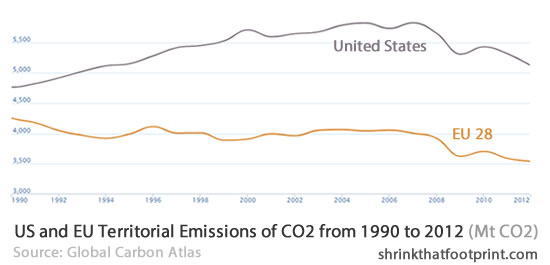Has Germany Subsidized The World’s Now-Cheap Solar Power?
Originally published on Shrink That Footprint.
By Lindsay Wilson
One of the most curious memes that has developed over the last few years is that the US leads the world in tackling carbon emissions. Without as much as a breath this is typically followed by a sentence with the word ‘fracking‘. But if you actually look at the data you can see declining oil use was as big a driver in the cuts.
Looking at data has a nasty habit of skewering memes you see. US carbon emissions fell by 12.1% between 2005 and 2012 (see above). Over the same period in the EU28 emissions fell by 12.4%. So while both have done very well the EU edged it since 2005, the year that the US happens to use as its baseline.
For most countries of course the baseline for emissions is 1990, the one from the Kyoto Protocol. With 1990 as a baseline US emissions figures are less flattering, up 7.4%. Europe is down 16.7%. So much for that meme then.
One of things with trying to lead on climate change is that it really is a scrappy business. Europe has done well on efficiency standards, but struggled to get its emissions trading smoothly off the ground. It’s doing well on fuel economy in cars, but been slow to deal with particulates from vehicles. On solar, it really looks to be paying the price of being a solar leader. Let me show you what I mean.
The other day I was reading a piece by Giles over at the excellent RenewEconomy which showed a graph of global PV module demand. The stacked bar chart for each year was hiding some fascinating data, so I’ve cut a new chart to show you what’s happening in the five main solar countries over the last few years.
For Germany and Italy this graph looks incredibly painful to me.
If you know anything about the cost of solar you’ll realize that the shape of the German and Italian demand curves indicate a very expensive affair. Those gigawatts installed from 2010 and 2011 could be installed at a fraction of their cost today. Given the falling costs of solar, the ramp-up in China and the US looks much more natural. This begs a question.
Has cloudy Germany done the heavy lifting, with its high feed-in tariffs and manufacturing investment, thus allowing the likes of China, the US and Japan to install so much solar today? Or did Germany push to0 hard too early on, leaving itself with a subsidy bill that is curtailing current investment in solar?
I’m not really sure to be honest. It’s a bit easy to criticize with 20/20 hindsight. But I still have the feeling that it is a bit of both. Maybe something else is at play? I am sure that the shape of that curve in Germany looks eye-wateringly expensive.
Is this the price of solar leadship?
Have a tip for CleanTechnica? Want to advertise? Want to suggest a guest for our CleanTech Talk podcast? Contact us here.
Latest CleanTechnica.TV Video

CleanTechnica uses affiliate links. See our policy here.



